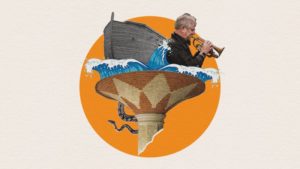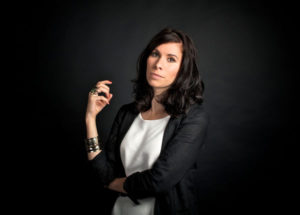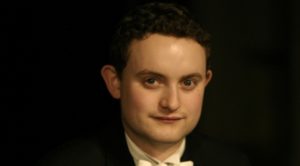
Carnival at Crystal Palace
Hello! Read below to find our more about the people, pieces and instruments in this concert.
Scenes from Noye’s Fludde
Benjamin Britten (1913-1976)
by William Vann
Noah and the Great Flood is perhaps the best known of the Chester Mystery Plays, local performances of biblical stories which are recorded as being performed as early as 1422. They dealt with subjects from the Creation to the Last Judgement, and were performed by local craftsmen and tradesmen of the town and their families on a small cart that moved across the town and between villages: hence the staging and scenic devices were simple, and contained.
The first performances of Benjamin Britten’s Noye’s Fludde were given in Orford Church in June 1958 as part of the Aldeburgh Festival of that year, and were conducted by Charles Mackerras. Britten chose an edition of the Chester text by Alfred W. Pollard and put together one of the most ingenious operas of all time, a blend of a powerful narrative with a unique mixture of performing forces. The orchestra consists of a small concertino group of professional musicians performing alongside a ripieno orchestra of strings, recorders, bugles, hand-bells and percussion and the congregation joins in three times by singing hymns, inserted into the text, thus providing an extra layer of commentary to the proceedings on stage. There are eight solo singing parts, those of Noye, Mrs Noye, Sem, Ham and Jaffett and their wives and one speaking role, that of God. Thus Britten unifies a wide range of ages and musical abilities into one magnificent performance.
Carnival of the Animals
Camille Saint-Saëns (1835–1921)
by Elizabeth Boulton
I Introduction and Royal March of the Lion
II Hens and Roosters
III Wild Asses; quick animals
IV Tortoises
V The Elephant
VI Kangaroos
VII Aquarium
VIII Characters with Long Ears
IX The Cuckoo in the Depths of the Woods
X Aviary
XI Pianists
XII Fossils
XIII The Swan
XIV Finale
Once described as the French Mendelssohn, Camille Saint-Saëns was talented and precocious as a child, with interests by no means confined to music. He made an early impression as a pianist. Following established French tradition, he was for nearly 20 years organist at the Madeleine in Paris and taught briefly at the École Niedermeyer, where he befriended his pupil Gabriel Fauré. He was a co-founder of the important Société Nationale de Musique with the patriotic aim of promoting contemporary French music in the aftermath of the Franco-Prussian war of 1870/1, in which he had served in the Garde Nationale de la Seine. Prolific and versatile as a composer, he contributed to most genres of music, but by the time of his death in 1921 his popularity in France had diminished considerably, as fashions in music had changed.
In 1885 Saint-Saëns wrote a witty, uncomplicated piece called Wedding Cake (1885), which to his chagrin became so popular that he gained a temporary reputation as a ‘light’ composer. Because he wanted to be considered a composer of serious, substantial music, he suppressed Carnival of the Animals shortly after its première in the following year. However, this ‘zoological fantasy’, one of the most successful examples of humourously themed music in the repertory, has become one of the composer’s most popular works. Carnival of the Animals, cast as a suite of 14 short pieces, is scored for an ensemble comprising two pianos, two violins, viola, cello, double bass, flute, clarinet and glockenspiel.
The work begins with a roar from the two pianos and low strings, an appropriate introduction to the “Royal March of the Lions”. The crowing and pecking of strings effectively evokes the clamour of hens and roosters, while the depiction of tortoises takes the form of a sly musical joke: a drastically slowed-down version of the famous can-can from Offenbach’s Orpheus in the Underworld (1858). Saint-Saëns continues to parody his countrymen when he uses the “Waltz of the Sylphs” from Berlioz’s The Damnation of Faust (1846) in depicting elephants. Graceful and rapid leaps on the keyboard naturally describe kangaroos. Liquid, rippling sounds on the piano and a magical, serene melody characterise one of the loveliest sections of the work, a sound portrait of an aquarium. Sliding string figures give voice to mules, whose braying is sharply contrasted with the deeply mysterious beauty of the clarinet in its imitation of a cuckoo. This single bird becomes an entire aviary aflutter with airy flute solos and rapid keyboard passagework. Saint-Saëns admits pianists themselves into the menagerie, good-naturedly mocking their hours of practice with a passage that unfolds as a ponderous keyboard exercise. “Fossils” pays homage to those creatures which have suffered extinction with the suggestion of rattling bones in the xylophone, including a quotation from the composer’s own Danse macabre (1874). This is followed by the most famous movement, one so lovely that the composer permitted its publication as a solo work. “The Swan” has become a staple of every cellist’s repertoire and a favourite accompaniment for dance works. The brisk finale includes a spirited, exuberant reprise of all of the animals’ themes.
Player List
Simon Blendis leader
Alex Ashworth Noye
Kate Symonds-Joy Mrs Noye
Will Vann conductor
Father John Pritchard narrator/God
Freddie Balcombe Sem
Oliver Barlow Ham
Josh Webb Jaffett
Emmylou Lloyd-Tucker Mrs Jaffett
Anna Rush Mrs Sem
Eva Purnell Mrs Ham
Julie Dean recorder soloist
Crystal Palace Recorders
Linda Walker
Linda Stowe
Chris Stringfellow
Georgia Marriott
Eleanor Green
Handbell Players from SAS Ringers, Sanderstead 2O’Clock Bells and The Wandle Ringers
Soloists from Trinity Boys Choir and Streatham and Clapham High School
Orchestra from Cypress School
Plus local students and amateur musicians
Violin 1
Simon Blendis
Rachel New
Aarna Wangoo
Violin 2
Jennifer Godson
Roanna Gibson
Violin 3
Fiona Thompson
Viola
Christine Anderson
Cello
Sebastian Comberti
Lyra Lloyd-Evans
Ella Rooke
Double Bass
Christopher West
Flute and Piccolo
Harry Winstanley
Clarinet
TBC
Trumpet 1
Peter Wright
Trumpet 3
William Jones
Timpani and Percussion
Tom Lee
Oliver Butterworth
Liz Woodhouse
Adam Payne
Piano
Sophia Rahman
Caroline Dowdle (Noye’s Fludde)
Dominic Doutney (Carnival of the Animals)
Biographies

Alex Ashworth
Noye
Alex studied at the Royal Academy of Music and has since made his debut with opera houses including Glyndebourne Festival Opera, Welsh National Opera and Scottish Opera. Abroad he has performed for the Opéra Comique in Paris, Opéra de Lille and the Icelandic Opera. He sings regularly on the concert platform and has worked as a soloist for conductors including Sir John Eliot Gardiner, Sir Colin Davis and Paul McCreesh. Alex teaches at the Royal Academy of Music. alexashworth.com

Kate Symonds-Joy
Mrs Noye
Kate graduated with a First Class music degree from Cambridge University and a DipRAM from the Royal Academy Opera Course. She has sung over the world in venues such as Sydney Opera House, Cadogan Hall and the Royal Albert Hall. Kate sings regularly as a core member of Solomon’s Knot Baroque Collective, who have appeared at the Aldeburgh Festival, Leipzig Bachfest, Wigmore Hall and Royal Albert Hall as part of the BBC Proms. She teaches the choral scholars of both St. John’s Voices and Gonville & Caius College, Cambridge. katesymonds-joy.com

William Vann
conductor
William is a multiple-prize winning and critically acclaimed conductor and accompanist, has performed in concert halls across the world and has made over twenty recordings for seven different record labels. He is an Associate of the Royal Academy of Music, a Fellow of the Royal College of Organists, the Director of Music at the Royal Hospital Chelsea, the Musical Director of Dulwich Choral Society, a Freeman of the Worshipful Company of Musicians and the Chairman of Kensington and Chelsea Music Society. williamvann.com


